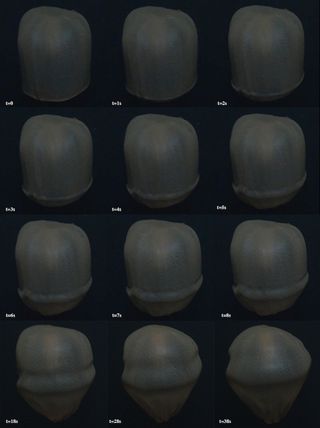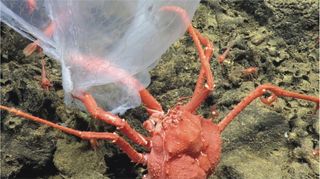This Mysterious, Deep-Sea Jellyfish Looks Like the Ghost of an Alien
The ROV, dubbed Hercules, recorded the unusual jellyfish — named Deepstaria enigmatica after the Deepstar 4000, a deep-sea submersible designed by the French explorer Jacques Cousteau — off the coast of Mexico's San Benedicto Island in the Pacific Ocean in November 2017, according to a new study published in the May 9 issue of the journal American Museum Novitates.
"It's just this crazy, weird alien thing," lead study researcher David Gruber, a professor of biology at the City University of New York and a Radcliffe fellow at Harvard University, told Live Science. "We barely know anything about it." [Image Gallery: Jellyfish Rule!]
Scientists have published studies on D. enigmatica only about a dozen times since 1966, when three researchers aboard the Deepstar 4000 captured the first specimen. Unfortunately, this specimen was incomplete; the jellyfish was so large, it couldn't be completely sucked up by the submersible's suction sampler, the researchers said.
Although that jellyfish was incomplete, "much of the existing information about D. enigmatica is from this specimen," which now resides at the British Natural History Museum, the researchers wrote in the study.
Here's what researchers do know about the odd creature. First, D. enigmatica has no tentacles, so it hunts by encapsulating prey within its gelatinous, umbrella-like body. And there aren't any reports on the species' diet, but like other jellyfish, it probably eats small fish, crustaceans and other jellyfish, Gruber said.
As Hercules began to film the jellyfish — a large jelly more than 2 feet (68 centimeters) long with a diameter of 1.8 feet (56 cm) — it closed its body in a rapid ripple. Gruber said the jellyfish may have mistaken the vibrations from the ROV as tasty prey and thus tried to bag it.
"[The jellyfish] sensed that maybe it had something potentially inside of it, and it closed," Gruber said.
Sign up for the Live Science daily newsletter now
Get the world’s most fascinating discoveries delivered straight to your inbox.

Jelly fall
After recording the mysterious jellyfish for about 10 minutes at nearly 3,200 feet (974 meters) below sea level, Hercules took a dive to the ocean floor — this time, at about 2,900 feet (899 m) below sea level, east of Mexico's Socorro Island.
Among the dense forest of sponges and corals, Hercules filmed bright-red crabs feasting on a dead Deepstaria, making it the first scientific record of a Deepstaria "jelly fall," which is akin to animals eating a dead whale after a whale fall, the researchers said. (There are two known species of Deepstaria: D. enigmatica and D. reticulum, and it's not clear which species the crabs were eating, Gruber noted.)

"There was a little crab party going on around this jelly," Gruber said. Food is so scarce in the deep sea, it's no wonder that animals down there were gobbling up this jellyfish, he said.
Gruber and his colleagues plan to explore more of the ocean with ROVs like Hercules, which can carry high-tech cameras (in this case, the Canon ME20F-SH) and whose spotlights can be dimmed to that of a mere penlight.
"Usually when submarines go down, they go down with these big, powerful lights because they don't want to bump into things and crash," Gruber said. "It's like being at a party outside and the cops come and shine a flashlight in your face. That's the kind of way we normally approach deep-sea life."
The low-light Hercules even managed to film a blue, bioluminescent creature known as Tomopteris swimming around the jellyfish.
"That's a feature that's normally missed using other cameras," Gruber said.
Original article on Live Science.

Laura is the archaeology and Life's Little Mysteries editor at Live Science. She also reports on general science, including paleontology. Her work has appeared in The New York Times, Scholastic, Popular Science and Spectrum, a site on autism research. She has won multiple awards from the Society of Professional Journalists and the Washington Newspaper Publishers Association for her reporting at a weekly newspaper near Seattle. Laura holds a bachelor's degree in English literature and psychology from Washington University in St. Louis and a master's degree in science writing from NYU.
Most Popular

